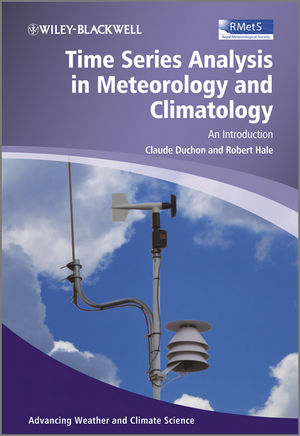
Time Series Analysis in Meteorology and Climatology
John Wiley & Sons Inc (Verlag)
978-0-470-97199-4 (ISBN)
- Titel z.Zt. nicht lieferbar
- Versandkostenfrei innerhalb Deutschlands
- Auch auf Rechnung
- Verfügbarkeit in der Filiale vor Ort prüfen
- Artikel merken
Students are encouraged to write their own computer programmes and data sets are provided to enable them to recognize quickly whether their programme is working correctly- one data set is provided with artificial data and the other with real data where the students are required to physically interpret the results of their periodgram analysis.
Based on the acclaimed and long standing course at the University of Oklahoma and part of the RMetS Advancing Weather and Climate Science Series, this book is distinct in its approach to the subject matter in that it is written specifically for readers in meteorology and climatology and uses a mix of theory and application to real data sets.
Claude Edward Duchon, Professor Emeritus, School of Meteorology, University of Oklahoma Robert C. Hale, Research Scientist, Cooperative Institute for Research in the Atmosphere, Colorado State University
Series foreword vii Preface ix
1. Fourier analysis 1
1.1 Overview and terminology 2
1.2 Analysis and synthesis 6
1.3 Example data sets 14
1.4 Statistical properties of the periodogram 23
1.5 Further important topics in Fourier analysis 47
Appendix 1.A Subroutine foranx 83
Appendix 1.B Sum of complex exponentials 86
Appendix 1.C Distribution of harmonic variances 86
Appendix 1.D Derivation of Equation 1.42 92
Problems 93
References 99
2. Linear systems 101
2.1 Input–output relationships 102
2.2 Evaluation of the convolution integral 104
2.3 Fourier transforms for analog data 110
2.4 The delta function 113
2.5 Special input functions 118
2.6 The frequency response function 122
2.7 Fourier transform of the convolution integral 128
2.8 Linear systems in series 130
2.9 Ideal interpolation formula 132
Problems 137
References 142
3. Filtering data 143
3.1 Recursive and nonrecursive filtering 144
3.2 Commonly used digital nonrecursive filters 150
3.3 Filter design 159
3.4 Lanczos filtering 161
Appendix 3.A Convolution of two running mean filters 173
Appendix 3.B Derivation of Equation 3.20 176
Appendix 3.C Subroutine sigma 177
Problems 180
References 182
4. Autocorrelation 183
4.1 Definition and properties 184
4.2 Formulas for the acvf and acf 188
4.3 The acvf and acf for stationary digital processes 192
4.4 The acvf and acf for selected processes 195
4.5 Statistical formulas 201
4.6 Confidence limits for the population mean 206
4.7 Variance of the acvf and acf estimators 211
Appendix 4.A Generating a normal random variable 215
Problems 216
References 221
5. Lagged-product spectrum analysis 223
5.1 The variance density spectrum 223
5.2 Relationship between the variance density spectrum and the acvf 226
5.3 Spectra of random processes 230
5.4 Spectra of selected processes 232
5.5 Smoothing the spectrum 236
Appendix 5.A Proof of Equation 5.11 239
Appendix 5.B Proof of Equation 5.12 240
Problems 241
References 243
Index 245
| Reihe/Serie | Advancing Weather and Climate Science |
|---|---|
| Verlagsort | New York |
| Sprache | englisch |
| Maße | 175 x 252 mm |
| Gewicht | 649 g |
| Themenwelt | Mathematik / Informatik ► Mathematik |
| Naturwissenschaften ► Geowissenschaften ► Geologie | |
| Naturwissenschaften ► Geowissenschaften ► Meteorologie / Klimatologie | |
| ISBN-10 | 0-470-97199-1 / 0470971991 |
| ISBN-13 | 978-0-470-97199-4 / 9780470971994 |
| Zustand | Neuware |
| Haben Sie eine Frage zum Produkt? |
aus dem Bereich


